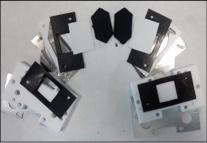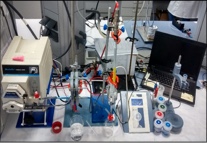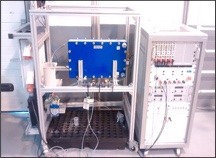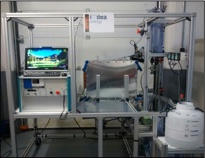Capacitive Deionization
Capacitive deionization (CDI) is an electrochemical water treatment process based on Electrical Double-Layer Capacitor (EDLCs) concepts, being recognized as a great example of the Water-Energy Nexus Technologies.
Significant efforts have been dedicated in our group to improving electrode properties by exploring different materials (metal oxide composites, CNT fibers, bio-waste based activated carbons films and pastes and 3D structures supporting active materials). Furthermore, relevant studies have been devoted also to explore different operational modes (potentiostatic, galvanostatic, and potentiodynamic) for singular applications. Finally, a scaling up process has been accomplished leading from CDI lab system of single cells (electrodes of 10 cm2) to pilot plants consisting of CDI stacks of several cells with larger electrodes (2400 cm2) and complete hydraulic, electric and control systems. Additionally, different software for operation and control of these CDI pilot plants have been developed.
 |
 |
 |
 |
Selected publications:
Lado, J. J., Cartolano, V., García–Quismondo, E., García G., Almonacid, I., Senatore V.,Naddeo, V.; Palma, J., Anderson, M.A. Performance Analysis of a Capacitive Deionization Stack for Brackish Water Desalination. Desalination (2021) 501, 114912. https://doi.org/10.1016/j.desal.2020.114912
Santos, C., Vázquez-Rodríguez, I., Lado, J. J., Vila, M., García–Quismondo, E., Anderson, M.A., Palma, J., Vilatela, Juan J. Low-energy consumption, free-form capacitive deionisation through nanostructured networks. Carbon (2021) 176, 390-399. https://doi.org/10.1016/j.carbon.2021.01.148
Wang, Y., Vázquez-Rodríguez, I., Santos, C., García–Quismondo, E., J., Palma, J., Anderson, M.A and Lado, J. J.*. Graphite Felt 3D Framework Composites as an Easy to Scale Capacitive Deionization Electrode for Brackish Water Desalination. Chem. Eng. Journal. (2019), 123698. https://doi.org/10.1016/j.cej.2019.123698
Santos, C., García–Quismondo, E., J., Palma, J., Anderson, M.A and Lado, J. J.* Understanding Capacitive Deionization Performance by Comparing Its Electrical Response with an Electrochemical Supercapacitor: Strategies to Boost Round-trip Efficiency. Electrochimica Acta, 2019, 330, 135216. https://doi.org/10.1016/j.electacta.2019.135216
Santos, C., Lado, J.J., García-Quismondo, E., Rodríguez, I.V., Hospital-Benito, D., Palma, J., Anderson, M.A., Vilatela, J.J. “Interconnected metal oxide CNT fibre hybrid networks for current collector-free asymmetric capacitive deionization”. Journal of Materials Chemistry A, 2018, 6 (23). 10898-10908. DOI: 10.1039/c8ta01128a.
Patents:
Electrode for capacitive deionization, P201730828 (22 June 2017). Vilatela, J.J.; Santos, C.; García-Quismondo, E.; Palma, J. Joint ownership with IMDEA Materials Institute
R&D Projects:
DC-SOIAS - Capacitive Deionization of Brines Coming from Brackish Water Reverse Osmosis Plants
This project aims to develop a technology of capacitive deionization, which allows the treatment of brine from desalination processes reverse osmosis (mainly underground or continental) brackish water, avoiding or minimizing the impact that this type of waste effluents It has on the environment and achieving a more efficient use of water resources to achieve an increase of at least 20% over the same freshwater inflow and the same energy consumption.


